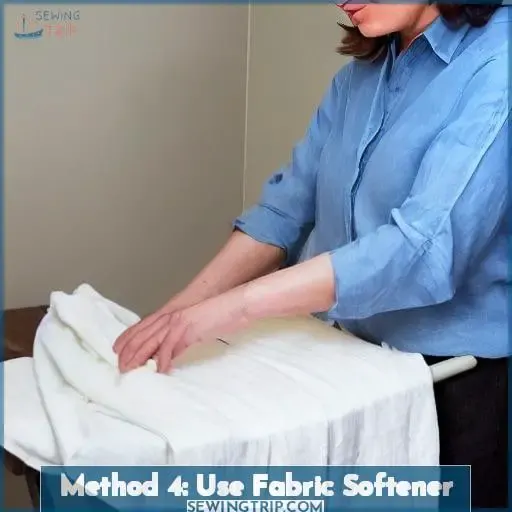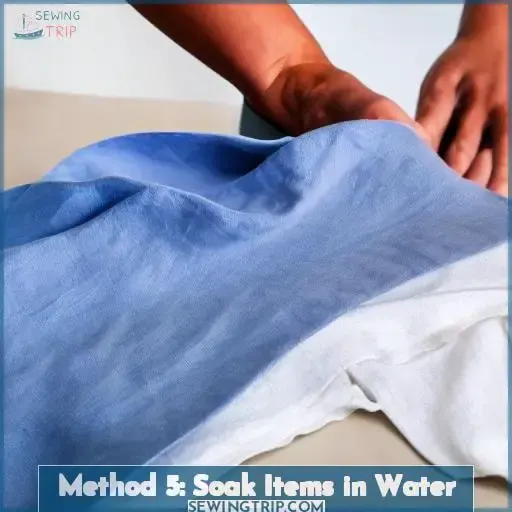This site is supported by our readers. We may earn a commission, at no cost to you, if you purchase through links.
Softening linen shirts can seem like an impossible task. But don’t worry – with a few easy steps, you too can make your linen pieces as soft and comfortable as cotton!
You may have heard traditional fabric softeners aren’t suitable for this material, but luckily there are plenty of natural alternatives to choose from: white vinegar, baking soda or dryer balls.
Our guide will show you how to soften linen shirts – turn even the stiffest garments into something cozy and inviting in no time!
Table Of Contents
Method 1: Use White Vinegar

You can use white vinegar to naturally break down any chemical residues on your linen shirts, making them softer and more comfortable with each wash. Combine 1 cup of white vinegar with a cold water bath in the washing machine. This method is much better than using fabric softener; it prevents wrinkles and won’t damage the fibers like regular bleaching techniques or ironing tricks would.
Air-drying tips come into play when dealing with delicate fabrics such as linen – hang-dry after each wash instead of putting it in a dryer. Proper folding methods are essential if you want to keep your clothes wrinkle-free; always fold linens along their creases so they don’t form permanent wrinkles over time.
Method 2: Use Baking Soda
You can add a cup of baking soda to your washing machine when you wash linen shirts for an extra boost of softness. Baking soda is a natural fabric softener that helps break down chemicals from previous washes and makes the linen softer over time.
Pre-soak or pre-wash in a solution with baking soda before laundering. Add 1/4 cup of baking soda along with detergent during the regular cycle. Use steam cleaning or ironing techniques while dampening the shirt first. Air dry instead of using heaters, as this will prevent shrinkage and help soften further. Hand wash delicate pieces by soaking them in warm water mixed with one tablespoon each of vinegar and baking powder.
With these tips, you’ll be able to get even more comfortable wear out of your favorite linen clothing!
Method 3: Use Dryer Balls
Try using dryer balls to help fluff up your linen shirts and make them more comfortable. Dryer balls are a natural alternative to dryer sheets that can prevent over-drying and add moisture back into the air during the drying cycle. They work by bouncing around in the machine, separating clothes, and allowing warm air to circulate freely.
Here’s how you can use dryer balls on your linen fabrics:
| Step | Instruction |
|---|---|
| 1 | Toss 2-3 wool or plastic-based dryer balls into your washing machine with your linen shirt before starting it |
| 2 | Once finished washing, remove any excess water from the garment by gently wringing it out or pressing down lightly |
| 3 | Air dry for best results or tumble dry on low heat setting with additional wool/ plastic-based ball(s) |
| Remember not to over-dry as this may cause wrinkling! Additionally, steam ironing is another great way of softening rough fibers while keeping their shape intact. With these tips in mind, you’ll be able to soften up even stubbornly scratchy pieces like a cozy linen sweater! |
Method 4: Use Fabric Softener
Don’t be tempted to cuddle up with fabric softener when trying to make your linen shirt softer – it’ll leave you feeling like a bear hug gone wrong! Traditional fabric softeners aren’t ideal for linen clothing, as they can affect the texture and prevent it from naturally softening.
Hang dry your shirts after washing them on gentle cycle. Air drying is better than throwing them in the dryer if you want a softer feel.
Try using natural alternatives such as white vinegar and baking soda instead of traditional fabric softener when washing linens. This’ll help break down any chemicals left behind from previous washes, while still giving you that desired crispness without sacrificing comfortability or durability over time.
Ironing before wearing also helps achieve maximum smoothness while avoiding wrinkles in between wears. But do so carefully, by dampening first then using a pressing cloth on top of garment before doing so.
After each wash session, add more natural softeners such as lavender oil, which has great calming effects too! These additional steps may take extra time, but result in better quality garments that last longer even through constant wear and tear cycles within the laundering process.
Method 5: Soak Items in Water
If you’re looking for a more natural option, try soaking your linen shirts in water to help them become softer and more comfortable. Just fill up a sink or bucket with lukewarm water and add one cup of white vinegar. Soak the linen items for 30 minutes, then rinse them out with cold water.
This process can be repeated as often as needed until the desired results are attained – no need for harsh chemicals! Pay attention to temperature control. Iron temperatures shouldn’t exceed 140°F (60°C). Air drying or hang drying will give better results than machine drying at higher temperatures.
With careful attention to temperature regulation, you’ll soon have linen fabric that’s much softer than its stiff feel prior!
Method 6: Use Additives
Give your linen shirt a luxurious feel by adding additives like baking soda or white vinegar to the washing cycle for an irresistibly smooth texture. Ironing temps should be kept low to keep fibers from becoming too stiff, and stain prevention is important. Natural softeners like vinegar and baking soda are great options for keeping your linen garments looking their best without harsh chemicals. Adding dryer balls can help fluff fabrics during laundering and reduce wrinkles after drying. Stone-washing can also soften linens naturally over time with wear and washing.
Following these tips will bring out that perfect combo of comfort, durability, and style every time you put on one of those beautiful linen shirts!
Method 7: Wear and Wash
By washing and wearing your linen shirt regularly, you can help it naturally become softer over time. Air drying the fabric after a cold wash in regular laundering cycles can speed up the process. Pre-soaking with half cup white vinegar in a bathtub full of water before air drying will help soften them quickly and make them more comfortable. A low ironing temp will help set the fibers, retaining their smoothness better when worn or washed again.
These simple steps and you’ll soon be enjoying luxurious comfort from your favorite linen shirts!
Frequently Asked Questions (FAQs)
How often should I wash my linen shirt?
You should wash your linen shirt regularly to maintain its softness and prevent wrinkles. Ironing tips such as air drying the shirt after the first wash, pre-treating any stains with a damp cloth, using low temperatures when washing and ironing can also help you keep it wrinkle free.
Different ways of softening linen shirts have been discussed elsewhere on this site but ultimately regular washing will improve its natural softness over time; for example two washes rather than one may make all the difference – especially if you add baking soda or white vinegar in small quantities during your second wash cycle.
Additionally, different types of fabric like cotton or silk blends may require additional steps to achieve softer results when laundering linen sheets too!
Is it safe to use fabric softener on linen?
Are you looking for the luxe feel of soft linen but don’t want to sacrifice its durability? Don’t worry, fabric softeners aren’t your only option. It may be tempting to use fabric softener on your linen shirts, but it’s probably best avoided. It adds unnecessary chemical residue and can prevent natural fibers from getting softer over time.
Try more natural methods instead. Cold soak laundry or hand wash with white vinegar and baking soda. Iron with proper technique while dampening the garment. Air-dry rather than machine dry. These will help bring out that desired comfort without compromising its longevity.
How long should I soak my linen shirt in vinegar and water?
Ironing and pre-soaking your linen shirt in a solution of vinegar and water are two of the best techniques to make it soft for any summer getaway wardrobe. Whether you’re looking to create an open-weave knit or just soften up that crisp linen garment, soaking your shirt in vinegar does have its benefits.
After washing as usual, fill up a sink with lukewarm water and add 1/2 cup white distilled vinegar—this will help break down chemicals from previous washes while also providing a natural fabric softener. Soak for about 30 minutes before wringing it out gently. Then air dry or place into the dryer on low heat setting using dryer balls, which can further add some extra cushioning!
Ironing tips such as dampening the item beforehand is recommended if needed, since ironing can help smooth out wrinkles but may not always result in softer fabrics like cotton or silk blends. So be sure to keep that in mind when trying this method too!
Does wearing my linen shirt multiple times help to soften it?
Wearing your linen shirt multiple times is an effective way to soften it up. The fabric will become less stiff and rough with a lot of wear. Saltwater soaks, air drying, cold washing in a full washing machine, steam ironing or hand scrubbing can all help. These techniques combined will give you best results, making your linen clothing much more comfortable and giving you relief from the sometimes harshness of pure linens!
Is there a difference between using baking soda or vinegar to soften linen?
When it comes to softening linen shirts, many people wonder if there is a difference between using baking soda or vinegar. The answer is yes! Baking soda works best with softer textiles like cotton and silk, while vinegar is better for 100% linen fabrics.
Air-drying after washing can help prevent shrinkage. Ironing with starch can give the fabric a smoother finish as well as soften it. Line drying in the sun will naturally soften your shirt over time.
Handwashing and hand ironing are great methods of softening linen garments without chemical treatments from brands like J. Crew or Amazon Associate Readers with Wardrobe Oxygen Reader Affiliate Links. These methods have been tested by fashion experts, so you know they work!
Conclusion
In conclusion, there are several effective methods to soften linen shirts. The best method for you will depend on the type of linen you have and the desired result. Vinegar, baking soda, and dryer balls are all excellent natural softeners. They’ll effectively soften linen without harsh chemicals.
Remember, wearing and washing your linen regularly will help to soften it over time. Use these methods to get the soft, comfortable linen experience you deserve. With a little care and attention, you can make linen shirts softer and more comfortable than ever before.












